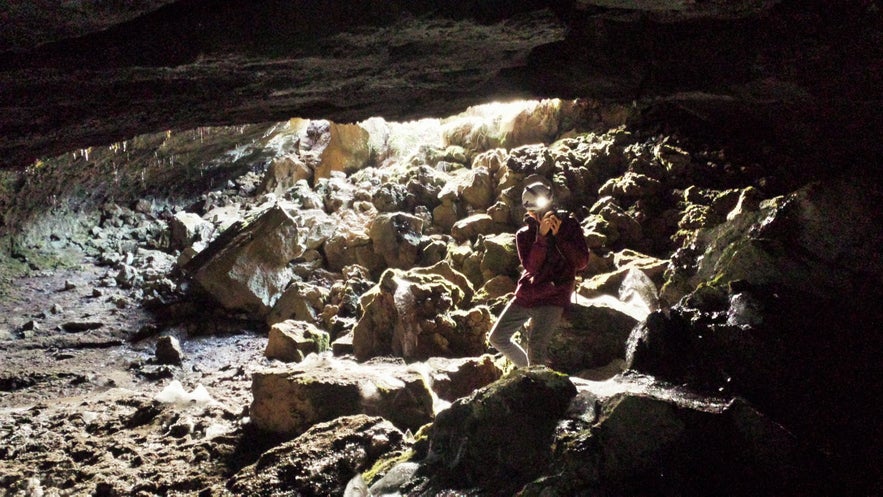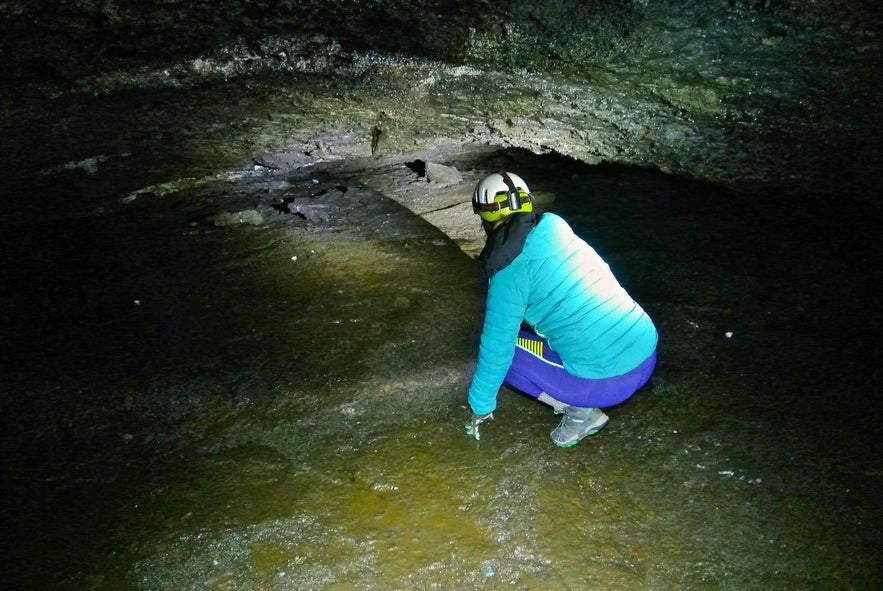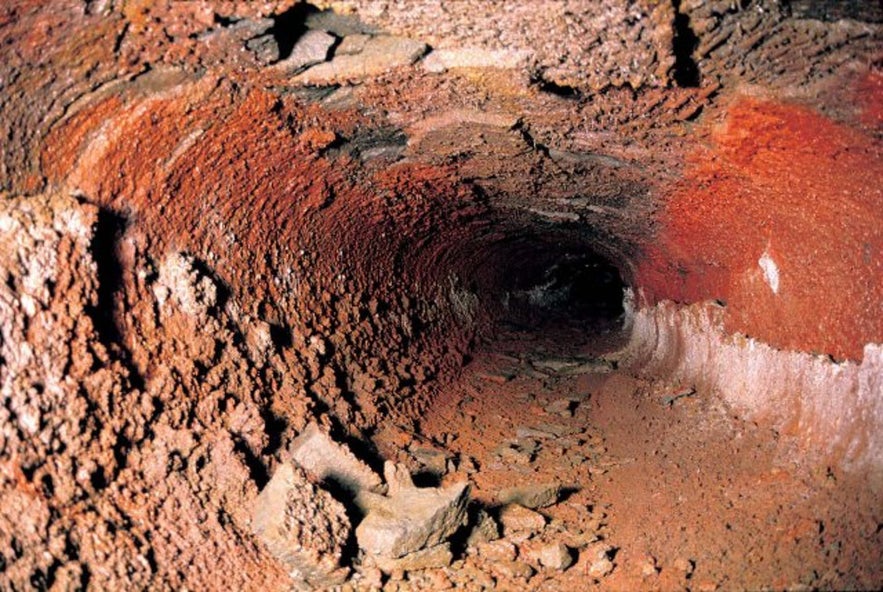
Leiðarendi is a lava tube located in a lava field close to Bláfjöll, the Blue Mountains, in southwest Iceland, about a 25 minutes drive from Reykjavík. Journeys in its depths reveal a wealth of knowledge about Icelandic history, geology and folklore.
Explore this cave with a knowledgable guide on this Cave Adventure Tour. Alternatively, if using Reykjavik as a base, make the most of the city on a Reykjavik tour.
Hvorfor du kan stole på innholdet vårt
Guide to Iceland er Islands mest brukte reiseplattform og hjelper millioner av besøkende hvert år. Tekstene våre er skrevet og sjekket av folk som bor her og kjenner landet ut og inn. Derfor kan du alltid regne med ærlige, oppdaterte og pålitelige reisetips.
Geology of Leiðarendi
Leiðarendi is, in fact, two caves, formed by two separate eruptions on the explosive Reykjanes Peninsula, one two thousand years ago, the other one thousand years ago.
During each, rivers of lava slowly cooled from the outside as they travelled from their erupting craters. A hard rock shell formed over the molten liquid, and as this flushed out, a hollow tube was left. In this case, the two caves collapsed into each other, leaving a circular path with a few hidden chambers.
After another collapse from above, Leiðarendi became accessible.
Leiðarendi is notable for its incredibly diverse and colourful scenery and is considered a prime example of an Icelandic lava tube. The kaleidoscope of colour comes from the minerals brought up in an eruption, with the red from iron, the yellow from sulfur, and the green from copper.
A distinctive feature of Leidarendi is various lava flakes that have fallen from its walls and roof, due to frost and erosion. These flakes indicate the many different lava streams that have flowed there subsequently throughout the ages.
In the cave, you will further see cave walls polished by lava streams along with stalagmites, stalactites and other fascinating formations. It is essential you do not take these, as unlike in limestone caves, they never grow back.
In winter you are likely to see glistening natural ice sculptures in the cave, adding further beauty to the already otherworldly scene.
Folklore and Mysteries in Leiðarendi
 Photo from Leidarendi Lava Tube | Cave Adventure from Reykjavik
Photo from Leidarendi Lava Tube | Cave Adventure from Reykjavik
Lava caves were historically feared and avoided at all costs. In winter, they can be incredibly dangerous, with jagged rocks, slippery floors, and a blackness so dark that it is impossible to navigate once the light has been lost.
In pre-industrial times, many lives were lost by people falling into caves, or climbing into them for warmth when travelling and getting trapped inside. As such, folklore developed around them, to ensure adults and children alike gave them a wide berth.
The main element of this was that they were said to be the homes of trolls. Trolls were considered to be proud, stupid, brutal and magical, and in most stories would eat any who could not outwit them for the smallest of reasons. Trespassing into a troll’s home was thus asking for punishment.
There were reasons other than the natural and supernatural perils for Icelanders to avoid caves, however. Soon after settlement, they became home to bandits and outlaws, who, expelled by the Icelandic parliament from society, would shelter in them to avoid the authorities and plunder travellers.
As Iceland modernised and developed more industry and rule of law, cave-dwelling bandits all but disappeared. However, neither their history nor their stigma ended here.
Without the social security systems it has in place today, impoverished people in Iceland who could not afford a place to stay had a choice between freezing to death by October each winter or leaving the towns for an empty cave to call home. This sad chapter in the lives of many Icelanders lasted well into the twentieth century.
It is not believed that Leiðarendi itself had a specific troll rumoured to dwell in it, not known if any notorious bandits stayed there, and unlikely that any poor people were forced to move into it. It does, however, have a dark secret of its own.
In the depths of one of its longest corridors, now protected by a chain, Leiðarendi has an eroding skeleton.
It takes a few minutes of observation to realise what it is: a collapsed ram. When first discovered, it caused quite a stir, with the initial belief being that it was brought down by a bandit; after all, punishment for stealing a sheep at different times in Iceland was death, so it would make sense to use this as a hiding place.
The sheep’s bones, however, were carbon dated, and it appears to be just over a hundred years old. Analysts summarised that it likely fled into Leiðarendi when fleeing in panic from a volcanic eruption, or else seeking protection during a violent storm. Its legs all seemed to be broken before it died.
Considering it is right at the back of the cave, it is a testament to how easy it is to get lost in the darkness of the subterranean world. It is also a gruelling reminder of how painful and unforgiving a death in a lava cave can be for the unprepared.
Visiting Leiðarendi
Because of the dangers of lava caves, they should only be visited with a guide on a sanctioned tour. Guides know the lava caves in and out, are trained to help in an emergency and will provide you with all the proper equipment.
The main components of this are a helmet and light, without which no one should be underground in any circumstances. In winter, you will also be provided with crampons.
To prepare of a tour of Leiðarendi, you should have sturdy boots, gloves for protection, and warm clothes throughout the year that you don’t mind getting damaged. Waterproofs will be appreciated, as lava rock is porous so a lot of water tends to trickle through the ceiling.
With all these, anyone who is sturdy on their feet and unafraid of small spaces should be able to enjoy a safe, beautiful and educational exploration here.
 Photo from Leidarendi Lava Tube | Cave Adventure from Reykjavik
Photo from Leidarendi Lava Tube | Cave Adventure from Reykjavik









